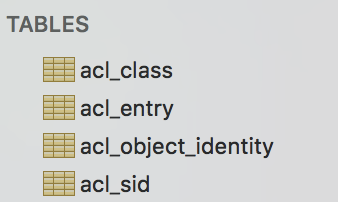想要细化权限控制粒度,办法很多。通过一个具体的案例来向小伙伴们展示基于 Acl 的权限控制。其他的权限控制模型后面也会一一介绍。
1.准备工作
首先创建一个 Spring Boot 项目,由于我们这里涉及到数据库操作,所以除了 Spring Security 依赖之外,还需要加入数据库驱动以及 MyBatis 依赖。
由于没有 acl 相关的 starter,所以需要我们手动添加 acl 依赖,另外 acl 还依赖于 ehcache 缓存,所以还需要加上缓存依赖。
最终的 pom.xml 文件如下:
<dependency>
<groupId>org.springframework.boot</groupId>
<artifactId>spring-boot-starter-security</artifactId>
</dependency>
<dependency>
<groupId>org.springframework.boot</groupId>
<artifactId>spring-boot-starter-web</artifactId>
</dependency>
<dependency>
<groupId>org.springframework.security</groupId>
<artifactId>spring-security-acl</artifactId>
<version>5.3.4.RELEASE</version>
</dependency>
<dependency>
<groupId>org.mybatis.spring.boot</groupId>
<artifactId>mybatis-spring-boot-starter</artifactId>
<version>2.1.3</version>
</dependency>
<dependency>
<groupId>mysql</groupId>
<artifactId>mysql-connector-java</artifactId>
</dependency>
<dependency>
<groupId>net.sf.ehcache</groupId>
<artifactId>ehcache</artifactId>
<version>2.10.4</version>
</dependency>
<dependency>
<groupId>com.alibaba</groupId>
<artifactId>druid-spring-boot-starter</artifactId>
<version>1.1.23</version>
</dependency>
<dependency>
<groupId>org.springframework</groupId>
<artifactId>spring-context-support</artifactId>
</dependency>
项目创建成功之后,我们在 acl 的 jar 包中可以找到数据库脚本文件:

根据自己的数据库选择合适的脚本执行,执行后一共创建了四张表,如下:

表的含义我就不做过多解释了
最后,再在项目的 application.properties 文件中配置数据库信息,如下:
spring.datasource.url=jdbc:mysql:///acls?useUnicode=true&characterEncoding=UTF-8&serverTimezone=Asia/Shanghai
spring.datasource.username=root
spring.datasource.password=123
spring.datasource.driver-class-name=com.mysql.cj.jdbc.Driver
至此,准备工作就算完成了。接下来我们来看配置。
2.ACL 配置
这块配置代码量比较大,我先把代码摆上来,我们再逐个分析:
@Configuration
@EnableGlobalMethodSecurity(prePostEnabled = true, securedEnabled = true)
public class AclConfig {
@Autowired
DataSource dataSource;
@Bean
public AclAuthorizationStrategy aclAuthorizationStrategy() {
return new AclAuthorizationStrategyImpl(new SimpleGrantedAuthority("ROLE_ADMIN"));
}
@Bean
public PermissionGrantingStrategy permissionGrantingStrategy() {
return new DefaultPermissionGrantingStrategy(new ConsoleAuditLogger());
}
@Bean
public AclCache aclCache() {
return new EhCacheBasedAclCache(aclEhCacheFactoryBean().getObject(), permissionGrantingStrategy(), aclAuthorizationStrategy());
}
@Bean
public EhCacheFactoryBean aclEhCacheFactoryBean() {
EhCacheFactoryBean ehCacheFactoryBean = new EhCacheFactoryBean();
ehCacheFactoryBean.setCacheManager(aclCacheManager().getObject());
ehCacheFactoryBean.setCacheName("aclCache");
return ehCacheFactoryBean;
}
@Bean
public EhCacheManagerFactoryBean aclCacheManager() {
return new EhCacheManagerFactoryBean();
}
@Bean
public LookupStrategy lookupStrategy() {
return new BasicLookupStrategy(dataSource, aclCache(), aclAuthorizationStrategy(), new ConsoleAuditLogger()
);
}
@Bean
public AclService aclService() {
return new JdbcMutableAclService(dataSource, lookupStrategy(), aclCache());
}
@Bean
PermissionEvaluator permissionEvaluator() {
AclPermissionEvaluator permissionEvaluator = new AclPermissionEvaluator(aclService());
return permissionEvaluator;
}
}
- @EnableGlobalMethodSecurity 注解的配置表示开启项目中 @PreAuthorize、@PostAuthorize 以及 @Secured 注解的使用,一会我们要通过这些注解配置权限。
- 由于引入了数据库的一整套东西,并且配置了数据库连接信息,所以这里可以注入 DataSource 实例以备后续使用。
- AclAuthorizationStrategy 实例用来判断当前的认证主体是否有修改 Acl 的权限,准确来说是三种权限:修改 Acl 的 owner;修改 Acl 的审计信息以及修改 ACE 本身。这个接口只有一个实现类就是 AclAuthorizationStrategyImpl,我们在创建实例时,可以传入三个参数,分别对应了这三种权限,也可以传入一个参数,表示这一个角色可以干三件事。
- PermissionGrantingStrategy 接口提供了一个 isGranted 方法,这个方法就是最终真正进行权限比对的方法,该接口只有一个实现类 DefaultPermissionGrantingStrategy,直接 new 就行了。
- 在 ACL 体系中,由于权限比对总是要查询数据库,造成了性能问题,因此引入了 Ehcache 做缓存。AclCache 共有两个实现类:SpringCacheBasedAclCache 和 EhCacheBasedAclCache。我们前面已经引入了 ehcache 实例,所以这里配置 EhCacheBasedAclCache 实例即可。
- LookupStrategy 可以通过 ObjectIdentity 解析出对应的 Acl。LookupStrategy 只有一个实现类就是 BasicLookupStrategy,直接 new 即可。
- AclService 这个我们在上文已经介绍过了,这里不再赘述。
- PermissionEvaluator 是为表达式 hasPermission 提供支持的。由于本案例后面使用类似于
@PreAuthorize("hasPermission(#noticeMessage, 'WRITE')")这样的注解进行权限控制,因此之类需要配置一个 PermissionEvaluator 实例。
至此,这里的配置类就和大家介绍完了。
3.情节设定
假设我现在有一个通知消息类 NoticeMessage,如下:
public class NoticeMessage {
private Integer id;
private String content;
@Override
public String toString() {
return "NoticeMessage{" +
"id=" + id +
", content='" + content + '\'' +
'}';
}
public Integer getId() {
return id;
}
public void setId(Integer id) {
this.id = id;
}
public String getContent() {
return content;
}
public void setContent(String content) {
this.content = content;
}
}
然后根据该类创建了数据表:
CREATE TABLE `system_message` (
`id` int(11) unsigned NOT NULL AUTO_INCREMENT,
`content` varchar(255) COLLATE utf8mb4_unicode_ci DEFAULT NULL,
PRIMARY KEY (`id`)
) ENGINE=InnoDB DEFAULT CHARSET=utf8mb4 COLLATE=utf8mb4_unicode_ci;
那么接下来的权限控制就是针对这个 NoticeMessage 的。
创建 NoticeMessageMapper,并添加几个测试方法:
@Mapper
public interface NoticeMessageMapper {
List<NoticeMessage> findAll();
NoticeMessage findById(Integer id);
void save(NoticeMessage noticeMessage);
void update(NoticeMessage noticeMessage);
}
NoticeMessageMapper.xml 内容如下:
<!DOCTYPE mapper
PUBLIC "-//mybatis.org//DTD Mapper 3.0//EN"
"http://mybatis.org/dtd/mybatis-3-mapper.dtd">
<mapper namespace="org.javaboy.acls.mapper.NoticeMessageMapper">
<select id="findAll" resultType="org.javaboy.acls.model.NoticeMessage">
select * from system_message;
</select>
<select id="findById" resultType="org.javaboy.acls.model.NoticeMessage">
select * from system_message where id=#{id};
</select>
<insert id="save" parameterType="org.javaboy.acls.model.NoticeMessage">
insert into system_message (id,content) values (#{id},#{content});
</insert>
<update id="update" parameterType="org.javaboy.acls.model.NoticeMessage">
update system_message set content = #{content} where id=#{id};
</update>
</mapper>
这些应该都好理解,没啥好说的。
接下来创建 NoticeMessageService,如下:
@Service
public class NoticeMessageService {
@Autowired
NoticeMessageMapper noticeMessageMapper;
@PostFilter("hasPermission(filterObject, 'READ')")
public List<NoticeMessage> findAll() {
List<NoticeMessage> all = noticeMessageMapper.findAll();
return all;
}
@PostAuthorize("hasPermission(returnObject, 'READ')")
public NoticeMessage findById(Integer id) {
return noticeMessageMapper.findById(id);
}
@PreAuthorize("hasPermission(#noticeMessage, 'CREATE')")
public NoticeMessage save(NoticeMessage noticeMessage) {
noticeMessageMapper.save(noticeMessage);
return noticeMessage;
}
@PreAuthorize("hasPermission(#noticeMessage, 'WRITE')")
public void update(NoticeMessage noticeMessage) {
noticeMessageMapper.update(noticeMessage);
}
}
涉及到了两个新注解,稍微说下:
- @PostFilter:在执行方法后过滤返回的集合或数组(筛选出当前用户具有 READ 权限的数据),returnObject 就表示方法的返回值。有一个和它对应的注解 @PreFilter,这个注解允许方法调用,但必须在进入方法之前对参数进行过滤。
- @PostAuthorize:允许方法调用,但是如果表达式计算结果为false,将抛出一个安全性异常,
#noticeMessage对应了方法的参数。 - @PreAuthorize:在方法调用之前,基于表达式的计算结果来限制对方法的访问。
明白了注解的含义,那么上面的方法应该就不用多做解释了吧。
配置完成,接下来我们进行测试。
4.测试
为了方便测试,我们首先准备几条测试数据,如下:
INSERT INTO `acl_class` (`id`, `class`)
VALUES
(1,'org.javaboy.acls.model.NoticeMessage');
INSERT INTO `acl_sid` (`id`, `principal`, `sid`)
VALUES
(2,1,'hr'),
(1,1,'manager'),
(3,0,'ROLE_EDITOR');
INSERT INTO `system_message` (`id`, `content`)
VALUES
(1,'111'),
(2,'222'),
(3,'333');
首先添加了 acl_class,然后添加了三个 Sid,两个是用户,一个是角色,最后添加了三个 NoticeMessage 实例。
目前没有任何用户/角色能够访问到 system_message 中的三条数据。例如执行如下代码获取不到任何数据:
@Test
@WithMockUser(roles = "EDITOR")
public void test01() {
List<NoticeMessage> all = noticeMessageService.findAll();
System.out.println("all = " + all);
}
@WithMockUser(roles = “EDITOR”) 表示使用 EDITOR 角色访问。松哥这里是为了方便。小伙伴们也可以自己给 Spring Security 配置用户,设置相关接口,然后 Controller 中添加接口进行测试,我这里就不那么麻烦了。
现在我们对其进行配置。
首先我想设置让 hr 这个用户可以读取 system_message 表中 id 为 1 的记录,方式如下:
@Autowired
NoticeMessageService noticeMessageService;
@Autowired
JdbcMutableAclService jdbcMutableAclService;
@Test
@WithMockUser(username = "javaboy")
@Transactional
@Rollback(value = false)
public void test02() {
ObjectIdentity objectIdentity = new ObjectIdentityImpl(NoticeMessage.class, 1);
Permission p = BasePermission.READ;
MutableAcl acl = jdbcMutableAclService.createAcl(objectIdentity);
acl.insertAce(acl.getEntries().size(), p, new PrincipalSid("hr"), true);
jdbcMutableAclService.updateAcl(acl);
}
我们设置了 mock user 是 javaboy,也就是这个 acl 创建好之后,它的 owner 是 javaboy,但是我们前面预设数据中 Sid 没有 javaboy,所以会自动向 acl_sid 表中添加一条记录,值为 javaboy。
在这个过程中,会分别向 acl_entry、acl_object_identity 以及 acl_sid 三张表中添加记录,因此需要添加事务,同时因为我们是在单元测试中执行,为了确保能够看到数据库中数据的变化,所以需要添加 @Rollback(value = false) 注解让事务不要自动回滚。
在方法内部,首先分别创建 ObjectIdentity 和 Permission 对象,然后创建一个 acl 对象出来,这个过程中会将 javaboy 添加到 acl_sid 表中。
接下来调用 acl_insertAce 方法,将 ace 存入 acl 中,最后调用 updateAcl 方法去更新 acl 对象即可。
配置完成后,执行该方法,执行完成后,数据库中就会有相应的记录了。
接下来,使用 hr 这个用户就可以读取到 id 为 1 的记录了。如下:
@Test
@WithMockUser(username = "hr")
public void test03() {
List<NoticeMessage> all = noticeMessageService.findAll();
assertNotNull(all);
assertEquals(1, all.size());
assertEquals(1, all.get(0).getId());
NoticeMessage byId = noticeMessageService.findById(1);
assertNotNull(byId);
assertEquals(1, byId.getId());
}
松哥这里用了两个方法来和大家演示。首先我们调用了 findAll,这个方法会查询出所有的数据,然后返回结果会被自动过滤,只剩下 hr 用户具有读取权限的数据,即 id 为 1 的数据;另一个调用的就是 findById 方法,传入参数为 1,这个好理解。
如果此时想利用 hr 这个用户修改对象,则是不可以的。我们可以继续使用上面的代码,让 hr 这个用户可以修改 id 为 1 的记录,如下:
@Test
@WithMockUser(username = "javaboy")
@Transactional
@Rollback(value = false)
public void test02() {
ObjectIdentity objectIdentity = new ObjectIdentityImpl(NoticeMessage.class, 1);
Permission p = BasePermission.WRITE;
MutableAcl acl = (MutableAcl) jdbcMutableAclService.readAclById(objectIdentity);
acl.insertAce(acl.getEntries().size(), p, new PrincipalSid("hr"), true);
jdbcMutableAclService.updateAcl(acl);
}
注意这里权限改为 WRITE 权限。由于 acl 中已经存在这个 ObjectIdentity 了,所以这里通过 readAclById 方法直接读取已有的 acl 即可。方法执行完毕后,我们再进行 hr 用户写权限的测试:
@Test
@WithMockUser(username = "hr")
public void test04() {
NoticeMessage msg = noticeMessageService.findById(1);
assertNotNull(msg);
assertEquals(1, msg.getId());
msg.setContent("javaboy-1111");
noticeMessageService.update(msg);
msg = noticeMessageService.findById(1);
assertNotNull(msg);
assertEquals("javaboy-1111", msg.getContent());
}
此时,hr 就可以使用 WRITE 权限去修改对象了。
假设我现在想让 manager 这个用户去创建一个 id 为 99 的 NoticeMessage,默认情况下,manager 是没有这个权限的。我们现在可以给他赋权:
@Test
@WithMockUser(username = "javaboy")
@Transactional
@Rollback(value = false)
public void test02() {
ObjectIdentity objectIdentity = new ObjectIdentityImpl(NoticeMessage.class, 99);
Permission p = BasePermission.CREATE;
MutableAcl acl = jdbcMutableAclService.createAcl(objectIdentity);
acl.insertAce(acl.getEntries().size(), p, new PrincipalSid("manager"), true);
jdbcMutableAclService.updateAcl(acl);
}
注意,这里的权限是 CREATE。
接下来使用 manager 用户就可以添加数据了:
@Test
@WithMockUser(username = "manager")
public void test05() {
NoticeMessage noticeMessage = new NoticeMessage();
noticeMessage.setId(99);
noticeMessage.setContent("999");
noticeMessageService.save(noticeMessage);
}
此时就可以添加成功了。添加成功后,manager 这个用户没有读 id 为 99 的数据的权限,可以参考前面案例自行添加。
5.小结
从上面的案例中大家可以看到,ACL 权限模型中的权限控制真的是非常非常细,细到每一个对象的 CURD。
优点就不用说了,够细!同时将业务和权限成功分离。缺点也很明显,权限数据量庞大,扩展性弱。

 随时随地看视频
随时随地看视频




